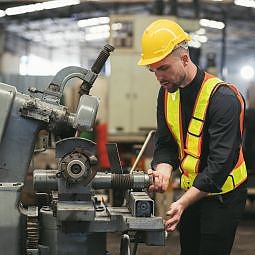
Many machines are still running in facilities that have been around since before the OSHA (Occupational Safety and Health Administration) set the standards for machine safety. Since those machines had a design without safeguarding in mind, there are two choices: replace them or find a way to add guards. Replacing machinery is expensive, so the better option is adding safeguards when the machine is still efficient and productive. For more information, read on as we discuss how to design guarding for older machines.
Moving parts on machines can cause severe injuries to workers. Some common injuries include crushed hands, burns, blindness, and amputations. Machine or safety guarding is usually in the form of a fence, shield, or barrier that allows a worker to perform their task while staying protected from any moving parts on the machine.
For some systems, guarding must be removable, while other machines work best with permanent guarding.
The first step in choosing the right guarding for an older machine is to assess the equipment. Check the following to determine the abilities of the machine and what type of design for guarding might work:
The OSHA sets the standard for machine guarding to protect machine operators and companies using machinery with moving parts. The organization breaks down the requirements that companies must adhere to for guarding into several specific areas. However, the general requirement is that any machine with parts that have the following must use some type of machine guarding to protect operators and employees:
Most hazardous areas stem from machines that use the following methods for production and operation:
OSHA requires older machines that use these motions and techniques to feature guarding for safety. To meet those requirements, a guard must be able to do the following:
When selecting guarding for an older machine, consider the following questions:
The design company will know what type of guarding your machinery needs, even if it’s an older one. One of the most important things to consider when designing guards for older machines is how the guard adheres to the equipment. The machine should be able to accommodate one of the following:
Fixed guarding is permanently attached so that no one can remove it. They are typically simple in design and easy to install.
The design of an interlocked guard uses a tripping mechanism, which causes the machine to cease operation as soon as the guard moves or is no longer there.
Adjustable guards are easy to adjust in size when there is a need to accommodate varying lengths of materials and stock.
Self-adjusting guards adjust on their own when sensing the need of varying sizes of stock that must go through.
The type of safety guard your machine needs will depend upon what purpose it serves, and in some cases, due to an older design, you may be limited on what kind of guard suits the machine.
With an older machine, it’s likely that the manufacturer no longer exists or doesn’t offer machine guarding that suits your machine, since requirements have changed. In that case and in many other cases, custom-designed guarding is best. There are many benefits to custom-designed guarding, and some of them are as follows:
You can’t go wrong with a custom design to ensure that the guarding fits properly, suits the older machine, and thoroughly protects everyone from dangerous equipment areas.
The three most common materials for machine guarding are wood, plastic, and metal, with metal being the most common and useful. However, with an older machine, you may have to choose what suits it best. Some older machines may need help to handle a specific material.
Plastic is common when the guarded area must be visible to operate the machine properly. Wood is usually only seen on woodworking machinery or when there is the use of chemical vapors that don’t interact well with metal. Otherwise, since wood is flammable, it’s sometimes not a safe choice. On the flip side, metal is highly durable and often used in all types of machine guarding.
A-line Automation has been in the industry for over 25 years and understands the importance of machine guarding for older machines and its impact on the manufacturing process. We design custom aluminum profiles for use in high-quality, durable guarding systems and more. If you need clarification on the guarding requirements or needs of your machinery, contact us, and we can create the design for you.
